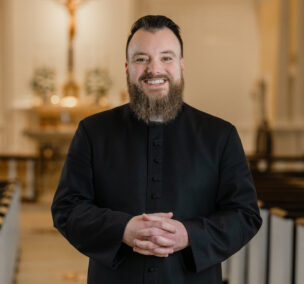Dear Brothers and Sisters in Christ,
Each year, the Third Sunday of Advent is an occasion to rejoice as the great feast of the Nativity draws near. These weeks of preparation are not meant to be a drudgery and burden, but a joy-filled movement toward the Lord who draws close to us. Last Sunday, we encountered St. John the Baptist, who called us to repentance. Today, we encounter him again as he teaches the people what repentance looks like: “share with the person who has none…stop collecting more than what is prescribed…do not practice extortion, do not falsely accuse anyone, and be satisfied with your wages.” These moral rules are a preparation for the one who “will baptize you with the Holy Spirit and fire,” and taken all together, this is good news for the people. There is rejoicing for those who listen to John the Baptist. St. Paul echoes this, calling on the community at Phillipi to rejoice in the Lord, just as the prophet Zephaniah called Israel to rejoice that the Lord had come to them. To prepare the way of the Lord, to have Him in our midst, to live as He created us to live, is to find true joy.
On this day of joy, we are reminded of a characteristic of one who rejoices. When we are filled with joy, we turn toward the object of our joy. Only after that turn has happened do we turn to anyone or anything else, and when we open that circle, it is to draw others into our joy. Think of a couple on their wedding day: their eyes are fixed on one another and the only reason they tear their gaze away is to share their joy with their guests. When the bride walks down the aisle, she doesn’t see the crowd of people smiling at her. She only sees her groom waiting. But when the wedding ends, bride and groom together, now married, turn and see their guests, and those attending are draw into their joy. For all the greeting of loved ones and friends required of the happy couple, though, you will notice that they never stop looking at each other, turning toward one another, for each has now become the source of joy for the other, and they cannot help but orient themselves to this cause of their rejoicing.
In the Mass, our attention is fixed on the source of our rejoicing, Jesus Christ. Physically, we orient ourselves toward Him with our postures standing, kneeling, and sitting. In a Mass celebrated ad orientem, as this weekend’s Masses are, the celebrant of the Mass adopts that same orientation with the whole gathered community. Together, as one body, we turn toward God, the one who is in our midst, as Zephaniah reminds us. Then, filled with joy, we will turn to each other even while we celebrate, so that our joy may not be something held individually but might now be shared with our brothers and sisters gathered with us. Our joy is meant to then overflow: “Go forth, the Mass is ended.” We are sent out: as the bride and groom are sent into the world as living witnesses of the truth of love made sacramental before God’s altar, so we are sent out having turned to our Lord and having received the sanctifying grace of the Eucharist, we might share the joy of living in and for Christ with the world we encounter. Sent forth, we will follow the exhortations of St. John the Baptist, conducting ourselves with righteousness and love as we wait in joyful hope for the coming of our Savior Jesus Christ.
If December 12 did not fall on a Sunday, we would celebrate the feast of Our Lady of Guadalupe, commemorating the Blessed Virgin Mary’s appearance to St. Juan Diego at Tepeyac, in modern-day Mexico City. There, she invited him, a poor native man, to tell the Bishop to build a chapel. The chapel would be a place of pilgrimage and prayer, a place where the joy of knowing, loving, and serving Jesus Christ would be celebrated. It would be a place that reminded all who visited of the true direction in which their lives must turn – not to a compass point, but to the Lord Jesus Christ. From the time of Mary’s visit to St. Juan Diego, the spread of the Gospel took off exponentially in Mexico. The Basilica of Our Lady of Guadalupe stands today as a place of pilgrimage, a point of reference for thousands upon thousands who visit each year, and who, having turned toward the Lord there, are able to turn outward that their joy in Jesus Christ might be shared. May our celebration of this day of rejoicing help us both to turn more and more to the coming Messiah, and to share our joy with the people and community around us.
Peace,
Fr. Sam


